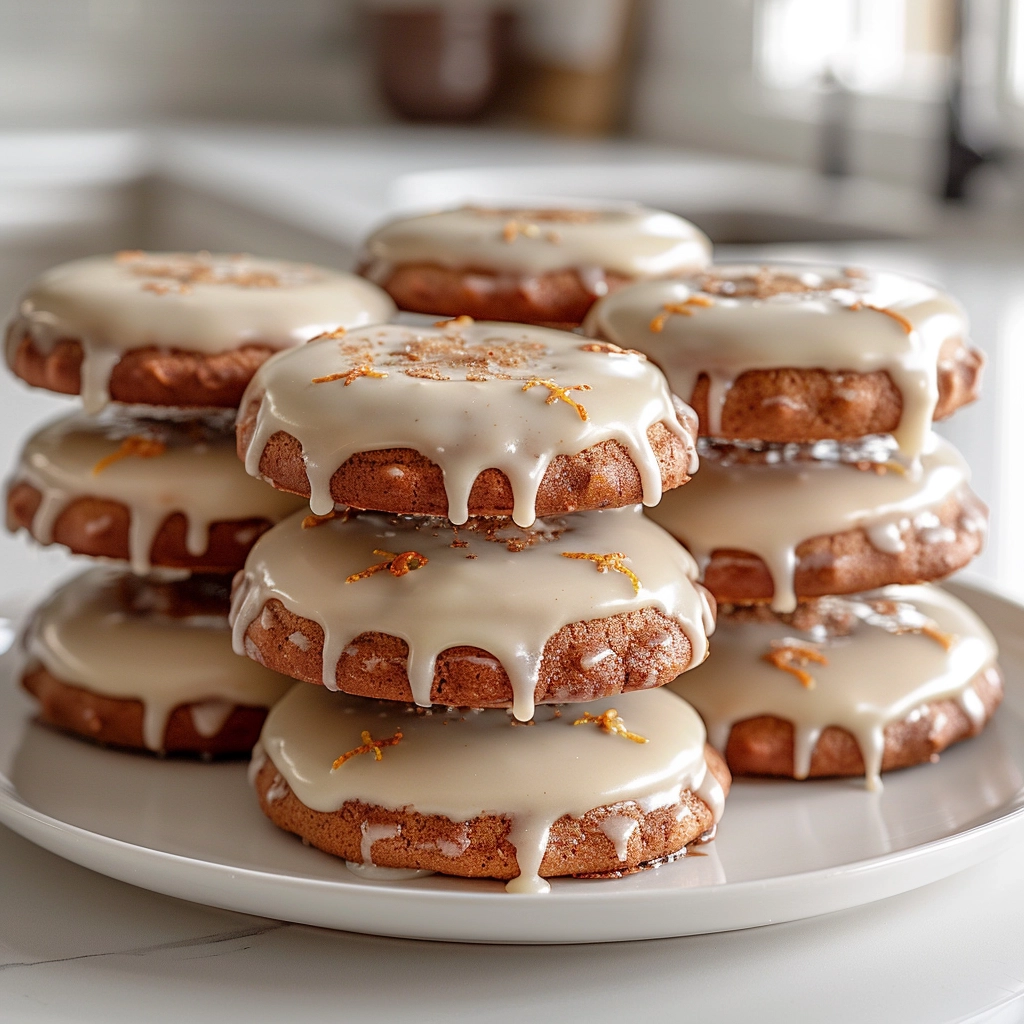If there’s one treat that instantly transports me to a bustling German Christmas market, it’s Traditional German Lebkuchen. These soft and chewy spiced cookies, packed with nuts and sweet candied peel, strike the perfect balance between nostalgic warmth and sophisticated flavor. Whether you love them glazed, dipped in chocolate, or simply as they are, Traditional German Lebkuchen is a festive favorite that fills the kitchen with irresistible holiday aromas.
Ingredients You’ll Need
The magic of Traditional German Lebkuchen comes from a handful of approachable yet essential ingredients. Each item in this recipe adds its unique touch, contributing to a cookie that’s layered with flavor, alluring in texture, and invitingly golden.
- Honey: Adds natural sweetness and gives the cookies their signature soft, chewy crumb.
- Brown Sugar: Deepens the flavor and helps keep the texture moist.
- Eggs: Bind all the ingredients together and ensure a tender, cake-like texture.
- Candied Lemon Peel: Offers bursts of citrus brightness in every bite.
- Candied Orange Peel: Balances the spice with gentle, zesty sweetness.
- Ground Almonds: Lend a nutty richness and help with that perfect dense crumb.
- Ground Hazelnuts: Add a classic German warmth and deepen the nutty flavor.
- Ground Cinnamon: The foundation of the spicy aroma that defines Lebkuchen.
- Ground Ginger: Brings a subtle heat that plays beautifully with honey and citrus.
- Ground Cloves: Infuses the cookies with just the right amount of bold, earthy spice.
- Ground Nutmeg: Complements the spices with mellow, subtle warmth.
- Salt: Enhances and balances the sweetness and spice.
- Baking Soda: Helps the cookies rise just enough for a soft, airy finish.
- Oblaten Wafers (optional): Traditional round wafers make serving a breeze and add authenticity.
- Powdered Sugar (for glaze, optional): For that irresistible snowy finish.
- Water or Lemon Juice (for glaze, optional): Lemon juice adds brightness to the glaze.
- Dark or Milk Chocolate (for coating, optional): A luscious, classic way to finish your cookies.
How to Make Traditional German Lebkuchen
Step 1: Prepare Your Baking Sheet
Start by preheating your oven to 325°F (165°C). Line a baking sheet with parchment paper or, if you have them, arrange the Oblaten wafers directly on the sheet. This quick setup keeps your cookies from sticking and, if you use the wafers, creates that classic Traditional German Lebkuchen appearance and soft bottom.
Step 2: Make the Wet Mixture
In a large mixing bowl, combine the honey, brown sugar, and eggs. Beat them together until the mixture is smooth and looks fluffy and pale. This not only blends everything together but also helps to trap air, resulting in cookies that are soft and light.
Step 3: Add Citrus and Nuts
Stir in the finely chopped candied lemon and orange peels. Next, mix in the ground almonds and ground hazelnuts. These ingredients bring a world of flavor and a dense, moist bite that makes Traditional German Lebkuchen so beloved. Try to fold gently for even distribution.
Step 4: Bring in the Spices
Sprinkle in the cinnamon, ginger, cloves, nutmeg, and salt, followed by the baking soda. Give everything a thorough mix so the spices are equally spread throughout the dough. Your kitchen will already start to smell festive at this point!
Step 5: Shape the Cookies
Drop heaping tablespoons of dough onto each Oblaten wafer or directly onto your lined sheet if you’re skipping the wafers. Use damp fingers to gently flatten each one, forming little domes. The dampness keeps the sticky dough from clinging to your hands as you shape the cookies.
Step 6: Bake to Perfection
Pop your tray into the oven and bake for 20 to 22 minutes. The cookies should be firm on top and lightly golden but still tender. They’ll finish setting as they cool, so be careful not to overbake—softness is key to authentic Traditional German Lebkuchen.
Step 7: Glaze or Coat with Chocolate (Optional)
Once completely cool, brush the tops with a simple glaze made from powdered sugar and water or lemon juice for a shiny, sweet finish. Or, for a decadent twist, dip the bottoms in melted chocolate or drizzle it generously over the tops. Allow the cookies to set until the glaze or chocolate is firm before storing or serving.
How to Serve Traditional German Lebkuchen
Garnishes
For a touch of elegance, sprinkle the glazed cookies with a little extra chopped candied peel while the glaze is still wet. You can also dust with a veil of powdered sugar to evoke fresh winter snow—my favorite for the ultimate cozy vibe.
Side Dishes
Traditional German Lebkuchen pairs beautifully with warm spiced drinks. Serve alongside a mug of mulled wine, spiced cider, or even a creamy hot chocolate. A crumbly wedge makes a dreamy companion to coffee or tea for a midafternoon treat.
Creative Ways to Present
Layer them in a festive tin lined with parchment for an eye-catching gift or stack and tie with a ribbon for a sweet holiday centerpiece. For a stunning Christmas dessert tray, alternate glazed and chocolate-coated Lebkuchen, tucked between sprigs of holly or cinnamon sticks.
Make Ahead and Storage
Storing Leftovers
Once fully cooled and set, keep your Traditional German Lebkuchen in an airtight container at room temperature. They actually taste even better after a day or two when the flavors settle and deepen. Stored properly, they’ll stay tender and delicious for up to two weeks.
Freezing
You can absolutely freeze Traditional German Lebkuchen. Place them in layers with parchment in between, in a freezer-safe container. Pop them in the freezer for up to three months. Let them thaw at room temperature—perfect for planning ahead during the busy holiday season.
Reheating
While these cookies are divine at room temperature, you can gently reheat them for a warm, bakery-fresh feel. Five minutes in a low oven (about 275°F) is all it takes. Avoid microwaving, as it can make them chewy and sticky rather than soft and tender.
FAQs
What are Oblaten wafers and do I need them for Traditional German Lebkuchen?
Oblaten are thin, edible baking wafers that form the base of authentic Lebkuchen, preventing sticking and offering a bit of traditional flair. However, you can absolutely bake these cookies without them; just use parchment paper for easy removal.
Can I substitute the nuts if I have an allergy?
Yes! You can swap the ground almonds and hazelnuts with more allergy-friendly seeds like sunflower or pumpkin seeds. The texture will be a bit different, but you’ll still get all that festive spice and chewiness.
Do Traditional German Lebkuchen need to be glazed or chocolate-coated?
It’s totally up to you! Classic Lebkuchen are delicious plain, but the glaze adds sweetness and a pretty sheen while chocolate brings decadent richness. Try both and see which version you love most.
How do I make the cookies chewier?
For extra chewiness, slightly underbake your Lebkuchen and ensure you don’t skimp on the honey. Storing them in an airtight container with a piece of apple or a slice of bread can also help keep them moist for longer.
Can I make Traditional German Lebkuchen ahead of time?
Absolutely! In fact, these cookies improve in flavor and texture when stored for a day or two before serving. Make a batch ahead, and enjoy easy, stress-free holiday hosting.
Final Thoughts
Baking Traditional German Lebkuchen is more than making cookies—it’s crafting a little piece of holiday magic, steeped in tradition and irresistible flavor. I can’t wait for you to share these with your loved ones and start your own delicious new traditions. Happy baking!
PrintTraditional German Lebkuchen
Traditional German Lebkuchen are soft, spiced cookies, reminiscent of gingerbread, packed with candied citrus peel, ground nuts, and warm spices. Baked on Oblaten wafers and optionally finished with a sweet glaze or decadent chocolate, these festive treats are a holiday favorite for their irresistible aroma and chewy texture.
- Prep Time: 20 minutes
- Cook Time: 22 minutes
- Total Time: 42 minutes
- Yield: 30 cookies 1x
- Category: Desserts
- Method: Baking
- Cuisine: German
- Diet: Vegetarian
Ingredients
Main Dough
- 3/4 cup honey
- 1 cup brown sugar
- 5 large eggs
- 1/2 cup candied lemon peel, finely chopped
- 1/2 cup candied orange peel, finely chopped
- 1 cup ground almonds
- 1 cup ground hazelnuts
- 2 tsp ground cinnamon
- 1 tsp ground ginger
- 1/2 tsp ground cloves
- 1/2 tsp ground nutmeg
- 1/4 tsp salt
- 1/2 tsp baking soda
- 30 Oblaten wafers (optional)
For the Glaze (optional)
- 1 cup powdered sugar
- 2 tbsp water or lemon juice
For Chocolate Coating (optional)
- 5 oz dark or milk chocolate, melted
Instructions
- Prepare the Oven and Baking Sheet: Preheat your oven to 325°F (165°C). Line a baking sheet with parchment paper, or if using Oblaten wafers, place them directly on the baking sheet.
- Mix Wet Ingredients: In a large bowl, beat together the honey, brown sugar, and eggs until the mixture is smooth, pale, and fluffy.
- Add Citrus and Nuts: Stir in the finely chopped candied lemon and orange peels, then add the ground almonds and hazelnuts to the mixture. This adds flavor and texture to your cookies.
- Incorporate Spices and Leavening: Sprinkle in the cinnamon, ginger, cloves, nutmeg, salt, and baking soda. Mix until everything is well combined into a sticky dough.
- Shape Cookies: Drop heaping tablespoons of dough onto the Oblaten wafers or the prepared baking sheet, leaving space between each. Gently flatten each mound with damp fingers to help them spread evenly while baking.
- Bake: Bake for 20–22 minutes, or until the tops are firm and lightly golden. Allow the cookies to cool completely on the tray as they will set further while cooling.
- Glaze (Optional): For a sweet finish, mix the powdered sugar with water or lemon juice to make a glaze. Brush this over fully cooled cookies and let them set.
- Chocolate Coating (Optional): For a chocolatey twist, dip the bottoms or drizzle the tops of cooled cookies with melted chocolate. Let the coating set fully before storing or serving.
Notes
- Oblaten wafers can often be found at specialty or European grocery stores, but parchment paper works well as a base if not available.
- Glazed and chocolate-coated cookies keep best in an airtight container, separated by parchment paper.
- Flavor improves after a day or two as the spices meld—these cookies store well for up to two weeks.
- For a nuttier version, you can adjust the ratio of almonds to hazelnuts as preferred.
- Let cookies cool completely before glazing or dipping in chocolate to ensure the coating sets properly.
Nutrition
- Serving Size: 1 cookie
- Calories: 190
- Sugar: 16g
- Sodium: 55mg
- Fat: 7g
- Saturated Fat: 1.5g
- Unsaturated Fat: 5g
- Trans Fat: 0g
- Carbohydrates: 29g
- Fiber: 2g
- Protein: 3g
- Cholesterol: 20mg


